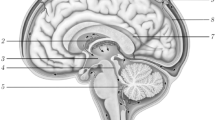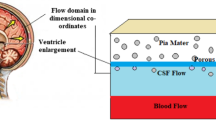Abstract
Hydrocephalus is a state in which the circulation of cerebrospinal fluid is disturbed. This fluid, produced within the brain at a constant rate, moves through internal cavities in it (ventricles), then exits through passages so that it may be absorbed by the surrounding membranes (meninges). Failure of fluid to move properly through these passages results in the distention of the passages and the ventricles. Ultimately, this distention causes large displacements and distortion of brain tissue as well as an increase of fluid in the extracellular space of the brain (edema). We use a two-phase model of fluid-saturated material to simulate the steady state of the hydrocephalic brain. Analytic solutions for the displacement of brain tissue and the distribution of edema for the annular regions of an idealized cylindrical geometry and small-strain theory are found. The solutions are used for a large-deformation analysis by superposition of the responses obtained for incrementally increasing loading. The effects of structural and hydraulic differences of white and gray brain matter, and the ependymal lining surrounding the venticles, are examined. The results reproduce the characteristic steady-state distribution of edema seen in hydrocephalus, and are compared with experiment.
Similar content being viewed by others
References
Atkin, R. J. and R. E. Craine. 1976. Continuum theories of mixtures: applications.J. Inst. Math. Appl. 17, 153.
Biot, M. A. 1941. General theory of three-dimensional consolidation.J. Appl. Phys. 12, 155.
Bowen, R. M. 1976. Theory of mixtures. InContinuum Physics, A. C. Eringen (Ed), Vol. II. New York: Academic.
Detournay, E. 1993. Fundamentals of poroelasticity. InComprehensive Rock Engineering: Principles, Practice, and Projects, C. Fairhurst (Ed). Elmsford, NY: Pergamon.
Drake, J. M., O. Mostachfi, G. Tenti and S. Sivaloganathan. 1996. Realistic simple mathematical model of brain biomechanics for computer simulation of hydrocephalus and other brain abnormalities.Can. J. Neurol. Sci. 23, S5 (abstract).
Fung, Y. C. 1994.A First Course in Continuum Mechanics for Physical Scientists and Engineers. Englewood Cliffs, NJ: Prentice-Hall.
Hakim, S. and C. Hakim. 1984. A biomechanical model of hydrocephalus and its relationship to treatment. InHydrocephalus, K. Shapiro and A. Marmarou (Eds). New York: Raven.
Hirano, A. 1993. Edema and myelin-associated extracellular spaces. InBrain Edema, Y. Inaba, I. Klatzo and M. Spatz (Eds). Berlin: Springer-Verlag.
Jayaraman, G. 1983. Water transport in the arterial wall—a theoretical study.J. Biomech. 16, 833.
Kaczmarek, M. 1992. On kinematics in the theory of multiphase media, comparison between two traditions.Mech. Res. Comm. 19, 361.
Kenyon, D. E. 1976. Transient filtration in porous elastic cylinder.J. Appl. Mech. 43, 594.
Klanchar, M. and J. M. Tarbell. 1987. Modeling water flow through arterial tissue.Bull. Math. Biol. 49.
Kumpel, H.-J. 1991. Poroelasticity: parameters reviewed.Geophys. J. Int. 105, 783.
Lux, W. E., G. M. Hochwald, A. Sahar and J. Ransohoff. 1970. Periventricular water content.Arch. Neurol. 23, 475.
Metz, H., J. McElhaney and A. K. Ommaya. 1970. A comparison of the elasticity of live, dead and fixed brain tissue.J. Biomech. 3, 453.
Mow, V. C., S. C. Kuei, W. M. Lai and C. G. Armstrong. 1980. Biphasic creep and stress relaxation of articular cartilage: theory and experiments.J. Biomech. Eng. 102, 73.
Nag, S. 1991. InTextbook of Neuropathology, R. L. Davis and D. M. Robertson (Eds), p. 95. Baltimore: William and Wilkins.
Nagashima, T., B. Horwitz and S. I. Rapoport. 1990. A mathematical model for vasogenic brain edema.Adv. Neurol. 52, 317.
Nagashima, T., N. Tanaki, S. Matsumoto, B. Horwitz and Y. Seguchi. 1987. Biomechanics of hydrocephalus: a new theoretical model.Neurosurgery 21, 898.
Nyberg-Hansen, R., A. Tovik and R. Bhatia. 1975. On the pathology of experimental hydrocephalus.Brain Res. 95, 343.
Oloyede, A. and N. D. Broom. 1991. Is classical consolidation theory applicable to articular cartilage deformation?Clin. Biomech. 6, 206.
Pasquini, U., M. Bronzini, E. Gozzoli, P. Mancini, F. Menichelli and U. Salvolini. 1977. Periventricular hypodensity in hydrocephalus: a clinico-radiological and mathematical analysis using computed tomography.J. Comp. Assist. Tomography 1, 443.
Rabenstain, A. L. 1972.Introduction to Ordinary Differential Equations. New York: Academic.
Rall, D. P., W. W. Oppelt and C. S. Patlak. 1962. Increased extracellular space of brain as determined by diffusion of inulin from the ventricular system.Life Sci. 1, 43.
Rekate, H. and W. Olivero. 1990.Hydrocephalus, R. M. Scott (Ed), p. 11. Baltimore: William and Wilkins.
Reulen, H. J., R. Graham, M. Spatz and I. Klatzo. 1977. Role of pressure gradients and bulk flow in dynamics of vasogenic brain edema.J. Neurosurgery 46, 24.
Subramaniam, R. P., S. R. Neff and R. Pakal. 1995. A numerical study of the biomechanics of structural neurologic diseases. InHigh Performance Computing 1995—Grand Challenges in Computer Simulation, A. Tentner (Ed), p. 552. San Diego: Society for Computer Simulation.
Weller, R. O. and J. Mitchell. 1980. Cerebrospinal fluid edema and its sequelae in hydrocephalus.Adv. Neurol. 28, 111.
Yang, M. and L. A. Taber. 1991. The possible role of poroelasticity in the apparent viscoelastic behavior of cardiac muscle.J. Biomech. 24, 587.
Author information
Authors and Affiliations
Corresponding author
Rights and permissions
About this article
Cite this article
Kaczmarek, M., Subramaniam, R.P. & Neff, S.R. The hydromechanics of hydrocephalus: Steady-state solutions for cylindrical geometry. Bltn Mathcal Biology 59, 295–323 (1997). https://doi.org/10.1007/BF02462005
Received:
Accepted:
Issue Date:
DOI: https://doi.org/10.1007/BF02462005




